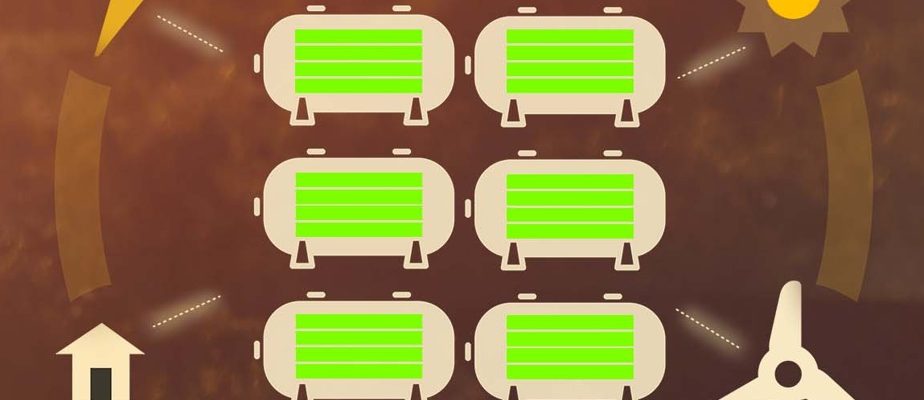(Washington) Six Goals
A 90% reduction in the cost of energy storage by 2030. This is one of the six objectives announced in 2021 by the US Department of Energy for energy transition. These are “Earthshots”, in reference to “Moonshots”, an expression designating ambitious projects, bordering on the eccentric.
At the AAAS conference, the department’s undersecretary of science, Geraldine Richmond, emphasized this issue. “If you include hydrogen, a third of our Earthshots are for renewable energy storage, isn’t that amazing? “said the chemist from Kansas, with an unusual verve in a scientist.
More than half a billion US dollars will be devoted over the next few years to around ten long-term storage technologies – ie more than 10 hours – of energy. They range from pumping liquids into elevated tanks to heating solids. The improvement of batteries is also on the menu, with investments of 6 billion US. The Hydrogen Earthshot aims to reduce the price of hydrogen produced from renewable energy by 80% to US$1 per kilo.
The case of Alaska
Last spring, M.me Richmond visited two solar power projects in Kotzebue and Utgiagvik, coastal villages in Alaska. The energy is stored there in batteries to ensure a continuous supply. “When these communities were powered by diesel generators, there was always background noise day and night,” said Ms.me Richmond. imagine the change [sans ce bruit] ! We are not just talking about energy transition, it is really a question of quality of life. »
Other Earthshots
- Reduce by 85% the emissions related to the industrial heating necessary for the treatment of materials, for example in the production of plastics and metals.
- Reduce CO capture and storage to US$100 per tonne2 atmospheric.
- Reduce the cost of geothermal energy by 90% to US$45 per megawatt hour.
- Reduce the cost of offshore wind energy by 95% to US$45 per megawatt hour.
The ammonia trail
Two speakers in a session on energy storage at the AAAS conference specialize in ammonia, a molecule composed of nitrogen and hydrogen that is gaseous but easily liquefied.
“In my opinion, it’s the fuel of the future,” said Bill David of the University of Oxford in England. “I initially worked on batteries, but I branched out to storage in gaseous form, because it is the only way to preserve the current infrastructures for the transport and use of energy. »

PHOTO FROM OXFORD UNIVERSITY WEBSITE
Bill David with his ammonia reactor
I started with hydrogen, but when I realized the potential of ammonia, it blew me away. Not only do we have a fuel without greenhouse gases, but we also eliminate the emissions linked to the current production of ammonia.
Bill David, from Oxford University
Mr. David presented the ammonia production reactor he designed. A chemist from Monash University in Australia, Alexandr Simonov, has gone even further: by 2025 he expects to be able to commercially produce, with his company JupiterIonics, ammonia from solar energy and the electrolysis of the water. “In three years, we have improved the process by a factor of ten,” Simonov said. Imagine what will be possible in the next few years. »
new fertilizers
Ammonia is currently used to make fertilizers, thanks to a very energy-intensive process invented a century ago, Haber-Bosch. “Haber-Bosch helped revolutionize agriculture, but its high temperatures and the need to use hydrogen from methane are a big problem,” says Simonov. I believe that within two decades, we will be able to produce fertilizers from renewable energies for less than Haber-Bosch. It’ll be slower than using ammonia as fuel, but it’ll come. »
When will we be able to replace Haber-Bosch with “green” ammonia? “We can think that by 2030, we will be able to introduce small green ammonia production units for regions poorly served by transport, for example in Africa”, said the chemist of Russian origin.
The example of Singapore

PHOTO FROM THE PORT OF SINGAPORE WEBSITE
Artist’s impression of an ammonia fueled ship
Mr. Simonov offered proof of the golden future of green ammonia: a company in Singapore has started work on the first ammonia-powered container ship. The Port of Singapore signed a design agreement last summer with Hyundai Shipyards for a line of ammonia-fueled vessels.

PHOTO FROM VOPAK WEBSITE
Vopak’s first two ammonia tanks in Singapore
The multinational industrial gas and liquids storage company Vopak of Singapore has started building ammonia tanks in the Asian port in anticipation of this transition. “Ammonia is better as a fuel than hydrogen, because it is liquid at 10 times lower pressure,” says Simonov. It can also be liquefied at -30°C, whereas for hydrogen, it is close to absolute zero [NDLR : -273 °C]. So we can design safe tanks for cars, for example. » Aren’t ammonia derivatives important car pollutants? “Yes, but there are catalysts to remove them from the exhaust,” says Simonov.
Learn more
-
- 10GWh
- Amount of energy storage installed in 2020 worldwide
SOURCE: INTERNATIONAL ENERGY AGENCY
- 1200 GWh
- Amount of energy storage installed planned for 2030 worldwide
SOURCE: INTERNATIONAL ENERGY AGENCY
-
- 160 million tons
- Ammonia production in the world
source : chemical and engineering news
- 500 million tons
- Global greenhouse gas emissions related to ammonia production
source : chemical and engineering news
-
- 1%
- Proportion of the world’s energy that is destined for the production of ammonia
source : chemical and engineering news
